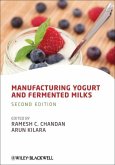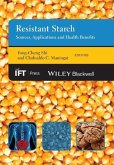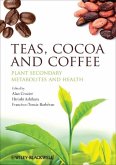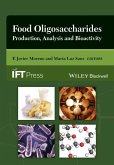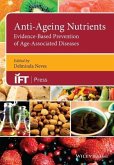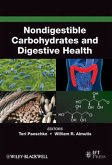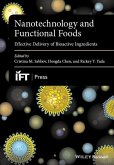Coffee
Emerging Health Effects and Disease Prevention
Ed. by Yi-Fang Chu
Coffee
Emerging Health Effects and Disease Prevention
Ed. by Yi-Fang Chu
- Gebundenes Buch
- Merkliste
- Auf die Merkliste
- Bewerten Bewerten
- Teilen
- Produkt teilen
- Produkterinnerung
- Produkterinnerung
Coffee: Emerging Health Benefits and Disease Prevention presents a comprehensive overview of the recent scientific advances in the field. The book focuses on the following topics: coffee constituents; pro- and antioxidant properties of coffee constituents; bioavailability of coffee constituents; health benefits and disease prevention effects of coffee; and potential negative impacts on health.
Multiple chapters describe coffee's positive impact on health and various diseases: type 2 diabetes; neurodegenerative diseases (Parkinson's and Alzheimer's); cancer (prostate, bladder, pancreatic,…mehr
Andere Kunden interessierten sich auch für
![Manufacturing Yogurt and Fermented Milks Manufacturing Yogurt and Fermented Milks]() Manufacturing Yogurt and Fermented Milks225,99 €
Manufacturing Yogurt and Fermented Milks225,99 €![Resistant Starch Resistant Starch]() Resistant Starch217,99 €
Resistant Starch217,99 €![Teas, Cocoa and Coffee Teas, Cocoa and Coffee]() Teas, Cocoa and Coffee240,99 €
Teas, Cocoa and Coffee240,99 €![Food Oligosaccharides Food Oligosaccharides]() Food Oligosaccharides249,99 €
Food Oligosaccharides249,99 €![Anti-Ageing Nutrients Anti-Ageing Nutrients]() Anti-Ageing Nutrients205,99 €
Anti-Ageing Nutrients205,99 €![Nondigestible Carbohydrates and Digestive Health Nondigestible Carbohydrates and Digestive Health]() Nondigestible Carbohydrates and Digestive Health260,99 €
Nondigestible Carbohydrates and Digestive Health260,99 €![Nanotechnology and Functional Foods Nanotechnology and Functional Foods]() Nanotechnology and Functional Foods205,99 €
Nanotechnology and Functional Foods205,99 €-
-
-
Coffee: Emerging Health Benefits and Disease Prevention presents a comprehensive overview of the recent scientific advances in the field. The book focuses on the following topics: coffee constituents; pro- and antioxidant properties of coffee constituents; bioavailability of coffee constituents; health benefits and disease prevention effects of coffee; and potential negative impacts on health.
Multiple chapters describe coffee's positive impact on health and various diseases: type 2 diabetes; neurodegenerative diseases (Parkinson's and Alzheimer's); cancer (prostate, bladder, pancreatic, breast, ovarian, colon and colorectal); cardiovascular health; and liver health. Coffee's positive effects on mood, suicide rate and cognitive performance are addressed as are the negative health impacts of coffee on pregnancy, insulin sensitivity, dehydration, gastric irritation, anxiety, and withdrawal syndrome issues.
Written by many of the top researchers in the world, Coffee: Emerging Health Benefits and Disease Prevention is a must-have reference for food professionals in academia, industry, and governmental and regulatory agencies whose work involves coffee.
Hinweis: Dieser Artikel kann nur an eine deutsche Lieferadresse ausgeliefert werden.
Multiple chapters describe coffee's positive impact on health and various diseases: type 2 diabetes; neurodegenerative diseases (Parkinson's and Alzheimer's); cancer (prostate, bladder, pancreatic, breast, ovarian, colon and colorectal); cardiovascular health; and liver health. Coffee's positive effects on mood, suicide rate and cognitive performance are addressed as are the negative health impacts of coffee on pregnancy, insulin sensitivity, dehydration, gastric irritation, anxiety, and withdrawal syndrome issues.
Written by many of the top researchers in the world, Coffee: Emerging Health Benefits and Disease Prevention is a must-have reference for food professionals in academia, industry, and governmental and regulatory agencies whose work involves coffee.
Hinweis: Dieser Artikel kann nur an eine deutsche Lieferadresse ausgeliefert werden.
Produktdetails
- Produktdetails
- Institute of Food Technologists Series
- Verlag: Wiley & Sons
- 1. Auflage
- Seitenzahl: 352
- Erscheinungstermin: 27. März 2012
- Englisch
- Abmessung: 259mm x 182mm x 23mm
- Gewicht: 852g
- ISBN-13: 9780470958780
- ISBN-10: 0470958782
- Artikelnr.: 34550457
- Herstellerkennzeichnung
- Libri GmbH
- Europaallee 1
- 36244 Bad Hersfeld
- gpsr@libri.de
- Institute of Food Technologists Series
- Verlag: Wiley & Sons
- 1. Auflage
- Seitenzahl: 352
- Erscheinungstermin: 27. März 2012
- Englisch
- Abmessung: 259mm x 182mm x 23mm
- Gewicht: 852g
- ISBN-13: 9780470958780
- ISBN-10: 0470958782
- Artikelnr.: 34550457
- Herstellerkennzeichnung
- Libri GmbH
- Europaallee 1
- 36244 Bad Hersfeld
- gpsr@libri.de
Dr Yi-Fang Chu was Head of the Global Coffee Wellness Research Group at Kraft Foods Global Inc., Glenview, Illinois, USA. He is currently with PepsiCo Global Nutrition, Barrington, Illinois
Preface xvii
List of Contributors xix
List of Abbreviations xxii
Acknowledgement xxv
1 Introduction 1
Thomas Hatzold
1.1 Coffee-a popular beverage 1
1.2 Coffee from a nutritional perspective 1
1.3 Potential beneficial effects of coffee 2
1.4 Limitations to the beneficial effects 3
1.5 History 5
1.6 Coffee production worldwide 5
1.7 Coffee processing: formation and fate of bioactive compounds 5
1.8 New processes to optimize the health benefits of coffee 10
1.9 Coffee preparation 12
1.10 Coffee beverages and specialties 14
1.11 Coffee consumption 14
1.12 Conclusions 16
2 Coffee Constituents 21
Adriana Farah
2.1 Introduction 21
2.2 Production of coffee and coffee-based beverages 22
2.3 Natural coffee constituents 26
2.4 Incidental coffee constituents 43
2.5 Concluding remarks 50
3 Bioavailability of Coffee Chlorogenic Acids 59
Angelique Stalmach
3.1 Introduction 59
3.2 Chlorogenic acids: contribution of coffee to dietary levels ingested 59
3.4 Conclusions 72
4 Coffee and Alzheimer's Disease: Animal and Cellular Evidence 77
Marshall G. Miller and Barbara Shukitt-Hale
4.1 Introduction 77
4.2 Alzheimer's disease 77
4.3 Coffee 81
4.4 Caffeine 82
4.5 Phenolics 86
4.6 Other coffee constituents 89
4.7 Conclusions 91
5 Coffee and Alzheimer's Disease-Epidemiologic Evidence 97
Joan Lindsay, Pierre-Hugues Carmichael, Edeltraut Kr¿oger, and Danielle
Laurin
5.1 Introduction 97
5.2 Review of epidemiologic studies of coffee in relation to Alzheimer's
disease, dementia, and selected aspects of cognitive functioning 98
5.3 The strength of the evidence for preventing Alzheimer's disease 106
6 Coffee and Parkinson's Disease 111
Jing-Wei Lim and Eng-King Tan
6.1 Introduction 111
6.2 Pathogenesis of Parkinson's disease 111
6.3 Gene and environmental/lifestyle factors 112
6.4 Clinical evidence linking coffee consumption and Parkinson's disease
113
6.5 Neuroprotection and active components of coffee 115
6.6 Adenosine receptor antagonism and Parkinson's disease 116
6.7 Caffeine rescue of Parkinson's disease in animal models 116
6.8 Clinical trials of adenosine receptor antagonists in Parkinson's
disease 117
6.9 Caffeine-mediated genetic susceptibility of Parkinson's disease 118
6.10 Summary 118
7 Coffee and Liver Health 123
Pablo Muriel and Jonathan Arauz
7.1 The liver 123
7.2 Epidemiologic studies 124
7.3 Coffee, fibrosis, and cirrhosis 124
7.4 Coffee and animal models of hepatic fibrosis 126
7.5 Cytokines and liver fibrosis 127
7.6 Mechanism of coffee's protective effect 128
7.7 Adenosine A2A receptors and caffeine 132
7.8 Caffeine metabolism and drug interactions 134
7.9 Conclusions 134
8 Coffee and Type 2 Diabetes Risk 141
Nathan V. Matusheski, Siamak Bidel, and Jaakko Tuomilehto
8.1 Introduction 141
8.2 Observational associations between coffee consumption and type 2
diabetes risk 142
8.3 Coffee preparation 154
8.4 Observational associations between coffee consumption and diabetes risk
factors 156
8.5 Intervention studies in human subjects 159
8.6 Possible mechanisms of action 166
8.7 Summary and conclusions 170
9 Coffee and Cardiovascular Diseases 181
Siamak Bidel and Jaakko Tuomilehto
9.1 Introduction 181
9.2 Coffee components and CVD 181
9.3 Early, transient, or acute effects of coffee consumption on CVD 183
9.4 Coffee metabolism and CVD: genetic influences 185
9.5 Long-term habitual coffee consumption and CVD 185
9.6 Coffee consumption and heart failure 189
9.7 Coffee consumption and stroke 189
9.8 Summary 190
10 Coffee and Cancers 197
Andre Nkondjock
10.1 Introduction 197
10.2 Breast cancer 198
10.3 Colorectal cancer 198
10.4 Prostate cancer 199
10.5 Bladder cancer 199
10.6 Gastric cancer 200
10.7 Ovarian cancer 201
10.8 Pancreatic cancer 201
10.9 Liver cancer 201
10.10 Head and neck cancers 202
10.11 Endometrial cancer 203
10.12 Kidney cancer 204
10.13 Brain cancer 204
10.14 Cancer survival 204
10.15 Conclusions 205
11 Coffee Consumption and Mortality Risk 211
Kemmyo Sugiyama, Shinichi Kuriyama, and Ichiro Tsuji
11.1 Introduction 211
11.2 Coffee consumption and all-cause mortality 211
11.3 Coffee consumption and CVD mortality 221
11.4 Coffee consumption and cancer mortality 222
11.5 Possible mechanism of CVD mortality reduction by coffee 223
11.6 Conclusions 223
12 Is Coffee the Next Red Wine? Coffee Polyphenol and Cholesterol Efflux
227
Harumi Kondo, Makoto Ayaori, and Katsunori Ikewaki
12.1 High-density lipoprotein and cardiovascular disease 227
12.2 Coffee and cardiovascular disease 227
12.3 Coffee polyphenols 228
12.4 Coffee polyphenols and cholesterol efflux 229
13 Additional Positive Impacts on Health 233
Yi-Fang Chu and Yumin Chen
13.1 Coffee intake and reduced risk of suicide 233
13.2 Enhanced cognitive performance and mood 235
13.3 Coffee bioactive compounds 236
14 Epidemiological Evidence for Maternal Prenatal Coffee and Caffeine
Consumption and Miscarriage Risk 243
Ronna L. Chan
14.1 Introduction 243
14.2 Coffee consumption during pregnancy: a three-decade-old concern 243
14.3 Evidence from the current literature 244
14.4 Methodological concerns and limitations for studies on coffee or
caffeine exposure and miscarriage 247
14.5 Risk for recurrent miscarriage 253
14.6 Conclusion, public health implications, and recommendations for future
studies 254
15 Acrylamide in Coffee 259
Richard H. Stadler and Viviane Theurillat
15.1 Introduction 259
15.2 Methods of analysis 260
15.3 Occurrence in coffee and exposure estimates 260
15.4 Mechanisms of formation 262
15.5 Mitigation options 264
15.6 Risk assessment and risk management 268
15.7 Conclusions 270
16 Impact of Coffee on Gastric Acid Secretion 275
Malte J. Rubach and Veronika Somoza
16.1 Introduction 275
16.2 Regulation of gastric acid secretion 276
16.3 Effects of coffee on gastric secretion 279
16.4 Optimization of coffee bean processing to reduce the gastric acid
stimulatory potential of coffee 285
16.5 Dietary impact on the gastric acid stimulatory potential of coffee 286
16.6 Conclusions 287
17 Potential Mental Risks 293
Emma Childs and Harriet de Wit
17.1 Epidemiology of coffee and other forms of caffeine 293
17.2 Beneficial effects of caffeine 295
17.3 Risks associated with caffeine use 296
17.4 Summary and conclusions 301
18 Furan in Coffee 307
Helmut Guenther
18.1 Introduction 307
18.2 Physical and chemical properties 307
18.3 Toxicology and risk assessment 307
18.4 Occurrence of furan in coffee 309
18.5 Conclusion 316
References 316
Index 319
List of Contributors xix
List of Abbreviations xxii
Acknowledgement xxv
1 Introduction 1
Thomas Hatzold
1.1 Coffee-a popular beverage 1
1.2 Coffee from a nutritional perspective 1
1.3 Potential beneficial effects of coffee 2
1.4 Limitations to the beneficial effects 3
1.5 History 5
1.6 Coffee production worldwide 5
1.7 Coffee processing: formation and fate of bioactive compounds 5
1.8 New processes to optimize the health benefits of coffee 10
1.9 Coffee preparation 12
1.10 Coffee beverages and specialties 14
1.11 Coffee consumption 14
1.12 Conclusions 16
2 Coffee Constituents 21
Adriana Farah
2.1 Introduction 21
2.2 Production of coffee and coffee-based beverages 22
2.3 Natural coffee constituents 26
2.4 Incidental coffee constituents 43
2.5 Concluding remarks 50
3 Bioavailability of Coffee Chlorogenic Acids 59
Angelique Stalmach
3.1 Introduction 59
3.2 Chlorogenic acids: contribution of coffee to dietary levels ingested 59
3.4 Conclusions 72
4 Coffee and Alzheimer's Disease: Animal and Cellular Evidence 77
Marshall G. Miller and Barbara Shukitt-Hale
4.1 Introduction 77
4.2 Alzheimer's disease 77
4.3 Coffee 81
4.4 Caffeine 82
4.5 Phenolics 86
4.6 Other coffee constituents 89
4.7 Conclusions 91
5 Coffee and Alzheimer's Disease-Epidemiologic Evidence 97
Joan Lindsay, Pierre-Hugues Carmichael, Edeltraut Kr¿oger, and Danielle
Laurin
5.1 Introduction 97
5.2 Review of epidemiologic studies of coffee in relation to Alzheimer's
disease, dementia, and selected aspects of cognitive functioning 98
5.3 The strength of the evidence for preventing Alzheimer's disease 106
6 Coffee and Parkinson's Disease 111
Jing-Wei Lim and Eng-King Tan
6.1 Introduction 111
6.2 Pathogenesis of Parkinson's disease 111
6.3 Gene and environmental/lifestyle factors 112
6.4 Clinical evidence linking coffee consumption and Parkinson's disease
113
6.5 Neuroprotection and active components of coffee 115
6.6 Adenosine receptor antagonism and Parkinson's disease 116
6.7 Caffeine rescue of Parkinson's disease in animal models 116
6.8 Clinical trials of adenosine receptor antagonists in Parkinson's
disease 117
6.9 Caffeine-mediated genetic susceptibility of Parkinson's disease 118
6.10 Summary 118
7 Coffee and Liver Health 123
Pablo Muriel and Jonathan Arauz
7.1 The liver 123
7.2 Epidemiologic studies 124
7.3 Coffee, fibrosis, and cirrhosis 124
7.4 Coffee and animal models of hepatic fibrosis 126
7.5 Cytokines and liver fibrosis 127
7.6 Mechanism of coffee's protective effect 128
7.7 Adenosine A2A receptors and caffeine 132
7.8 Caffeine metabolism and drug interactions 134
7.9 Conclusions 134
8 Coffee and Type 2 Diabetes Risk 141
Nathan V. Matusheski, Siamak Bidel, and Jaakko Tuomilehto
8.1 Introduction 141
8.2 Observational associations between coffee consumption and type 2
diabetes risk 142
8.3 Coffee preparation 154
8.4 Observational associations between coffee consumption and diabetes risk
factors 156
8.5 Intervention studies in human subjects 159
8.6 Possible mechanisms of action 166
8.7 Summary and conclusions 170
9 Coffee and Cardiovascular Diseases 181
Siamak Bidel and Jaakko Tuomilehto
9.1 Introduction 181
9.2 Coffee components and CVD 181
9.3 Early, transient, or acute effects of coffee consumption on CVD 183
9.4 Coffee metabolism and CVD: genetic influences 185
9.5 Long-term habitual coffee consumption and CVD 185
9.6 Coffee consumption and heart failure 189
9.7 Coffee consumption and stroke 189
9.8 Summary 190
10 Coffee and Cancers 197
Andre Nkondjock
10.1 Introduction 197
10.2 Breast cancer 198
10.3 Colorectal cancer 198
10.4 Prostate cancer 199
10.5 Bladder cancer 199
10.6 Gastric cancer 200
10.7 Ovarian cancer 201
10.8 Pancreatic cancer 201
10.9 Liver cancer 201
10.10 Head and neck cancers 202
10.11 Endometrial cancer 203
10.12 Kidney cancer 204
10.13 Brain cancer 204
10.14 Cancer survival 204
10.15 Conclusions 205
11 Coffee Consumption and Mortality Risk 211
Kemmyo Sugiyama, Shinichi Kuriyama, and Ichiro Tsuji
11.1 Introduction 211
11.2 Coffee consumption and all-cause mortality 211
11.3 Coffee consumption and CVD mortality 221
11.4 Coffee consumption and cancer mortality 222
11.5 Possible mechanism of CVD mortality reduction by coffee 223
11.6 Conclusions 223
12 Is Coffee the Next Red Wine? Coffee Polyphenol and Cholesterol Efflux
227
Harumi Kondo, Makoto Ayaori, and Katsunori Ikewaki
12.1 High-density lipoprotein and cardiovascular disease 227
12.2 Coffee and cardiovascular disease 227
12.3 Coffee polyphenols 228
12.4 Coffee polyphenols and cholesterol efflux 229
13 Additional Positive Impacts on Health 233
Yi-Fang Chu and Yumin Chen
13.1 Coffee intake and reduced risk of suicide 233
13.2 Enhanced cognitive performance and mood 235
13.3 Coffee bioactive compounds 236
14 Epidemiological Evidence for Maternal Prenatal Coffee and Caffeine
Consumption and Miscarriage Risk 243
Ronna L. Chan
14.1 Introduction 243
14.2 Coffee consumption during pregnancy: a three-decade-old concern 243
14.3 Evidence from the current literature 244
14.4 Methodological concerns and limitations for studies on coffee or
caffeine exposure and miscarriage 247
14.5 Risk for recurrent miscarriage 253
14.6 Conclusion, public health implications, and recommendations for future
studies 254
15 Acrylamide in Coffee 259
Richard H. Stadler and Viviane Theurillat
15.1 Introduction 259
15.2 Methods of analysis 260
15.3 Occurrence in coffee and exposure estimates 260
15.4 Mechanisms of formation 262
15.5 Mitigation options 264
15.6 Risk assessment and risk management 268
15.7 Conclusions 270
16 Impact of Coffee on Gastric Acid Secretion 275
Malte J. Rubach and Veronika Somoza
16.1 Introduction 275
16.2 Regulation of gastric acid secretion 276
16.3 Effects of coffee on gastric secretion 279
16.4 Optimization of coffee bean processing to reduce the gastric acid
stimulatory potential of coffee 285
16.5 Dietary impact on the gastric acid stimulatory potential of coffee 286
16.6 Conclusions 287
17 Potential Mental Risks 293
Emma Childs and Harriet de Wit
17.1 Epidemiology of coffee and other forms of caffeine 293
17.2 Beneficial effects of caffeine 295
17.3 Risks associated with caffeine use 296
17.4 Summary and conclusions 301
18 Furan in Coffee 307
Helmut Guenther
18.1 Introduction 307
18.2 Physical and chemical properties 307
18.3 Toxicology and risk assessment 307
18.4 Occurrence of furan in coffee 309
18.5 Conclusion 316
References 316
Index 319
Preface xvii
List of Contributors xix
List of Abbreviations xxii
Acknowledgement xxv
1 Introduction 1
Thomas Hatzold
1.1 Coffee-a popular beverage 1
1.2 Coffee from a nutritional perspective 1
1.3 Potential beneficial effects of coffee 2
1.4 Limitations to the beneficial effects 3
1.5 History 5
1.6 Coffee production worldwide 5
1.7 Coffee processing: formation and fate of bioactive compounds 5
1.8 New processes to optimize the health benefits of coffee 10
1.9 Coffee preparation 12
1.10 Coffee beverages and specialties 14
1.11 Coffee consumption 14
1.12 Conclusions 16
2 Coffee Constituents 21
Adriana Farah
2.1 Introduction 21
2.2 Production of coffee and coffee-based beverages 22
2.3 Natural coffee constituents 26
2.4 Incidental coffee constituents 43
2.5 Concluding remarks 50
3 Bioavailability of Coffee Chlorogenic Acids 59
Angelique Stalmach
3.1 Introduction 59
3.2 Chlorogenic acids: contribution of coffee to dietary levels ingested 59
3.4 Conclusions 72
4 Coffee and Alzheimer's Disease: Animal and Cellular Evidence 77
Marshall G. Miller and Barbara Shukitt-Hale
4.1 Introduction 77
4.2 Alzheimer's disease 77
4.3 Coffee 81
4.4 Caffeine 82
4.5 Phenolics 86
4.6 Other coffee constituents 89
4.7 Conclusions 91
5 Coffee and Alzheimer's Disease-Epidemiologic Evidence 97
Joan Lindsay, Pierre-Hugues Carmichael, Edeltraut Kr¿oger, and Danielle
Laurin
5.1 Introduction 97
5.2 Review of epidemiologic studies of coffee in relation to Alzheimer's
disease, dementia, and selected aspects of cognitive functioning 98
5.3 The strength of the evidence for preventing Alzheimer's disease 106
6 Coffee and Parkinson's Disease 111
Jing-Wei Lim and Eng-King Tan
6.1 Introduction 111
6.2 Pathogenesis of Parkinson's disease 111
6.3 Gene and environmental/lifestyle factors 112
6.4 Clinical evidence linking coffee consumption and Parkinson's disease
113
6.5 Neuroprotection and active components of coffee 115
6.6 Adenosine receptor antagonism and Parkinson's disease 116
6.7 Caffeine rescue of Parkinson's disease in animal models 116
6.8 Clinical trials of adenosine receptor antagonists in Parkinson's
disease 117
6.9 Caffeine-mediated genetic susceptibility of Parkinson's disease 118
6.10 Summary 118
7 Coffee and Liver Health 123
Pablo Muriel and Jonathan Arauz
7.1 The liver 123
7.2 Epidemiologic studies 124
7.3 Coffee, fibrosis, and cirrhosis 124
7.4 Coffee and animal models of hepatic fibrosis 126
7.5 Cytokines and liver fibrosis 127
7.6 Mechanism of coffee's protective effect 128
7.7 Adenosine A2A receptors and caffeine 132
7.8 Caffeine metabolism and drug interactions 134
7.9 Conclusions 134
8 Coffee and Type 2 Diabetes Risk 141
Nathan V. Matusheski, Siamak Bidel, and Jaakko Tuomilehto
8.1 Introduction 141
8.2 Observational associations between coffee consumption and type 2
diabetes risk 142
8.3 Coffee preparation 154
8.4 Observational associations between coffee consumption and diabetes risk
factors 156
8.5 Intervention studies in human subjects 159
8.6 Possible mechanisms of action 166
8.7 Summary and conclusions 170
9 Coffee and Cardiovascular Diseases 181
Siamak Bidel and Jaakko Tuomilehto
9.1 Introduction 181
9.2 Coffee components and CVD 181
9.3 Early, transient, or acute effects of coffee consumption on CVD 183
9.4 Coffee metabolism and CVD: genetic influences 185
9.5 Long-term habitual coffee consumption and CVD 185
9.6 Coffee consumption and heart failure 189
9.7 Coffee consumption and stroke 189
9.8 Summary 190
10 Coffee and Cancers 197
Andre Nkondjock
10.1 Introduction 197
10.2 Breast cancer 198
10.3 Colorectal cancer 198
10.4 Prostate cancer 199
10.5 Bladder cancer 199
10.6 Gastric cancer 200
10.7 Ovarian cancer 201
10.8 Pancreatic cancer 201
10.9 Liver cancer 201
10.10 Head and neck cancers 202
10.11 Endometrial cancer 203
10.12 Kidney cancer 204
10.13 Brain cancer 204
10.14 Cancer survival 204
10.15 Conclusions 205
11 Coffee Consumption and Mortality Risk 211
Kemmyo Sugiyama, Shinichi Kuriyama, and Ichiro Tsuji
11.1 Introduction 211
11.2 Coffee consumption and all-cause mortality 211
11.3 Coffee consumption and CVD mortality 221
11.4 Coffee consumption and cancer mortality 222
11.5 Possible mechanism of CVD mortality reduction by coffee 223
11.6 Conclusions 223
12 Is Coffee the Next Red Wine? Coffee Polyphenol and Cholesterol Efflux
227
Harumi Kondo, Makoto Ayaori, and Katsunori Ikewaki
12.1 High-density lipoprotein and cardiovascular disease 227
12.2 Coffee and cardiovascular disease 227
12.3 Coffee polyphenols 228
12.4 Coffee polyphenols and cholesterol efflux 229
13 Additional Positive Impacts on Health 233
Yi-Fang Chu and Yumin Chen
13.1 Coffee intake and reduced risk of suicide 233
13.2 Enhanced cognitive performance and mood 235
13.3 Coffee bioactive compounds 236
14 Epidemiological Evidence for Maternal Prenatal Coffee and Caffeine
Consumption and Miscarriage Risk 243
Ronna L. Chan
14.1 Introduction 243
14.2 Coffee consumption during pregnancy: a three-decade-old concern 243
14.3 Evidence from the current literature 244
14.4 Methodological concerns and limitations for studies on coffee or
caffeine exposure and miscarriage 247
14.5 Risk for recurrent miscarriage 253
14.6 Conclusion, public health implications, and recommendations for future
studies 254
15 Acrylamide in Coffee 259
Richard H. Stadler and Viviane Theurillat
15.1 Introduction 259
15.2 Methods of analysis 260
15.3 Occurrence in coffee and exposure estimates 260
15.4 Mechanisms of formation 262
15.5 Mitigation options 264
15.6 Risk assessment and risk management 268
15.7 Conclusions 270
16 Impact of Coffee on Gastric Acid Secretion 275
Malte J. Rubach and Veronika Somoza
16.1 Introduction 275
16.2 Regulation of gastric acid secretion 276
16.3 Effects of coffee on gastric secretion 279
16.4 Optimization of coffee bean processing to reduce the gastric acid
stimulatory potential of coffee 285
16.5 Dietary impact on the gastric acid stimulatory potential of coffee 286
16.6 Conclusions 287
17 Potential Mental Risks 293
Emma Childs and Harriet de Wit
17.1 Epidemiology of coffee and other forms of caffeine 293
17.2 Beneficial effects of caffeine 295
17.3 Risks associated with caffeine use 296
17.4 Summary and conclusions 301
18 Furan in Coffee 307
Helmut Guenther
18.1 Introduction 307
18.2 Physical and chemical properties 307
18.3 Toxicology and risk assessment 307
18.4 Occurrence of furan in coffee 309
18.5 Conclusion 316
References 316
Index 319
List of Contributors xix
List of Abbreviations xxii
Acknowledgement xxv
1 Introduction 1
Thomas Hatzold
1.1 Coffee-a popular beverage 1
1.2 Coffee from a nutritional perspective 1
1.3 Potential beneficial effects of coffee 2
1.4 Limitations to the beneficial effects 3
1.5 History 5
1.6 Coffee production worldwide 5
1.7 Coffee processing: formation and fate of bioactive compounds 5
1.8 New processes to optimize the health benefits of coffee 10
1.9 Coffee preparation 12
1.10 Coffee beverages and specialties 14
1.11 Coffee consumption 14
1.12 Conclusions 16
2 Coffee Constituents 21
Adriana Farah
2.1 Introduction 21
2.2 Production of coffee and coffee-based beverages 22
2.3 Natural coffee constituents 26
2.4 Incidental coffee constituents 43
2.5 Concluding remarks 50
3 Bioavailability of Coffee Chlorogenic Acids 59
Angelique Stalmach
3.1 Introduction 59
3.2 Chlorogenic acids: contribution of coffee to dietary levels ingested 59
3.4 Conclusions 72
4 Coffee and Alzheimer's Disease: Animal and Cellular Evidence 77
Marshall G. Miller and Barbara Shukitt-Hale
4.1 Introduction 77
4.2 Alzheimer's disease 77
4.3 Coffee 81
4.4 Caffeine 82
4.5 Phenolics 86
4.6 Other coffee constituents 89
4.7 Conclusions 91
5 Coffee and Alzheimer's Disease-Epidemiologic Evidence 97
Joan Lindsay, Pierre-Hugues Carmichael, Edeltraut Kr¿oger, and Danielle
Laurin
5.1 Introduction 97
5.2 Review of epidemiologic studies of coffee in relation to Alzheimer's
disease, dementia, and selected aspects of cognitive functioning 98
5.3 The strength of the evidence for preventing Alzheimer's disease 106
6 Coffee and Parkinson's Disease 111
Jing-Wei Lim and Eng-King Tan
6.1 Introduction 111
6.2 Pathogenesis of Parkinson's disease 111
6.3 Gene and environmental/lifestyle factors 112
6.4 Clinical evidence linking coffee consumption and Parkinson's disease
113
6.5 Neuroprotection and active components of coffee 115
6.6 Adenosine receptor antagonism and Parkinson's disease 116
6.7 Caffeine rescue of Parkinson's disease in animal models 116
6.8 Clinical trials of adenosine receptor antagonists in Parkinson's
disease 117
6.9 Caffeine-mediated genetic susceptibility of Parkinson's disease 118
6.10 Summary 118
7 Coffee and Liver Health 123
Pablo Muriel and Jonathan Arauz
7.1 The liver 123
7.2 Epidemiologic studies 124
7.3 Coffee, fibrosis, and cirrhosis 124
7.4 Coffee and animal models of hepatic fibrosis 126
7.5 Cytokines and liver fibrosis 127
7.6 Mechanism of coffee's protective effect 128
7.7 Adenosine A2A receptors and caffeine 132
7.8 Caffeine metabolism and drug interactions 134
7.9 Conclusions 134
8 Coffee and Type 2 Diabetes Risk 141
Nathan V. Matusheski, Siamak Bidel, and Jaakko Tuomilehto
8.1 Introduction 141
8.2 Observational associations between coffee consumption and type 2
diabetes risk 142
8.3 Coffee preparation 154
8.4 Observational associations between coffee consumption and diabetes risk
factors 156
8.5 Intervention studies in human subjects 159
8.6 Possible mechanisms of action 166
8.7 Summary and conclusions 170
9 Coffee and Cardiovascular Diseases 181
Siamak Bidel and Jaakko Tuomilehto
9.1 Introduction 181
9.2 Coffee components and CVD 181
9.3 Early, transient, or acute effects of coffee consumption on CVD 183
9.4 Coffee metabolism and CVD: genetic influences 185
9.5 Long-term habitual coffee consumption and CVD 185
9.6 Coffee consumption and heart failure 189
9.7 Coffee consumption and stroke 189
9.8 Summary 190
10 Coffee and Cancers 197
Andre Nkondjock
10.1 Introduction 197
10.2 Breast cancer 198
10.3 Colorectal cancer 198
10.4 Prostate cancer 199
10.5 Bladder cancer 199
10.6 Gastric cancer 200
10.7 Ovarian cancer 201
10.8 Pancreatic cancer 201
10.9 Liver cancer 201
10.10 Head and neck cancers 202
10.11 Endometrial cancer 203
10.12 Kidney cancer 204
10.13 Brain cancer 204
10.14 Cancer survival 204
10.15 Conclusions 205
11 Coffee Consumption and Mortality Risk 211
Kemmyo Sugiyama, Shinichi Kuriyama, and Ichiro Tsuji
11.1 Introduction 211
11.2 Coffee consumption and all-cause mortality 211
11.3 Coffee consumption and CVD mortality 221
11.4 Coffee consumption and cancer mortality 222
11.5 Possible mechanism of CVD mortality reduction by coffee 223
11.6 Conclusions 223
12 Is Coffee the Next Red Wine? Coffee Polyphenol and Cholesterol Efflux
227
Harumi Kondo, Makoto Ayaori, and Katsunori Ikewaki
12.1 High-density lipoprotein and cardiovascular disease 227
12.2 Coffee and cardiovascular disease 227
12.3 Coffee polyphenols 228
12.4 Coffee polyphenols and cholesterol efflux 229
13 Additional Positive Impacts on Health 233
Yi-Fang Chu and Yumin Chen
13.1 Coffee intake and reduced risk of suicide 233
13.2 Enhanced cognitive performance and mood 235
13.3 Coffee bioactive compounds 236
14 Epidemiological Evidence for Maternal Prenatal Coffee and Caffeine
Consumption and Miscarriage Risk 243
Ronna L. Chan
14.1 Introduction 243
14.2 Coffee consumption during pregnancy: a three-decade-old concern 243
14.3 Evidence from the current literature 244
14.4 Methodological concerns and limitations for studies on coffee or
caffeine exposure and miscarriage 247
14.5 Risk for recurrent miscarriage 253
14.6 Conclusion, public health implications, and recommendations for future
studies 254
15 Acrylamide in Coffee 259
Richard H. Stadler and Viviane Theurillat
15.1 Introduction 259
15.2 Methods of analysis 260
15.3 Occurrence in coffee and exposure estimates 260
15.4 Mechanisms of formation 262
15.5 Mitigation options 264
15.6 Risk assessment and risk management 268
15.7 Conclusions 270
16 Impact of Coffee on Gastric Acid Secretion 275
Malte J. Rubach and Veronika Somoza
16.1 Introduction 275
16.2 Regulation of gastric acid secretion 276
16.3 Effects of coffee on gastric secretion 279
16.4 Optimization of coffee bean processing to reduce the gastric acid
stimulatory potential of coffee 285
16.5 Dietary impact on the gastric acid stimulatory potential of coffee 286
16.6 Conclusions 287
17 Potential Mental Risks 293
Emma Childs and Harriet de Wit
17.1 Epidemiology of coffee and other forms of caffeine 293
17.2 Beneficial effects of caffeine 295
17.3 Risks associated with caffeine use 296
17.4 Summary and conclusions 301
18 Furan in Coffee 307
Helmut Guenther
18.1 Introduction 307
18.2 Physical and chemical properties 307
18.3 Toxicology and risk assessment 307
18.4 Occurrence of furan in coffee 309
18.5 Conclusion 316
References 316
Index 319


